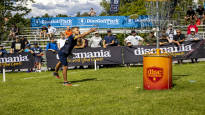The frisbee golf European Open, which landed in Finland last week, gathered an estimated 15,000 spectators for Nokia. The number is exceptional, and the attention the sport enjoys in Finland has not gone unnoticed by international players.
Last week, Finnish fans of frisbee golf gathered at Nokia, when the top tournament of the sport’s international umbrella organization, the PDGA European Open, was played in Finland. The event, which lasted from Wednesday to Sunday, saw the world’s top frisbee golfers and an estimated 15,000 people attended the five-day event. In the women’s competition, the reigning world champion, Estonia, won Kristin Buckwheat. Finland took the silver Heidi Laine. The open class was a celebration of the US players and you could lift the trophy Corey Ellis. Finland Väinö Mäkelä was ranked 11th as the best European.
On a global scale, the interest of the Finnish public in the tournament is exceptional, which has not been lost on the American frisbee golf professional, one of the pioneers of the sport From Nathan Sexton unawares.
– In Finland, frisbee golf has many fans and the media is interested in the sport.
Although frisbee golf has the status of a “small sport” in Finland, like in the United States, in Sexton’s opinion, the sport is still valued more in Finland than in the United States.
Frisbeegolf was originally developed in the United States at the turn of the 1960s and 1970s. In Finland, the strongest growth of the sport’s popularity so far dates back to the 2010s. The popularity of the sport was also increased by the corona pandemic, because after team sports were on break, low-threshold frisbee golf offered a good alternative to exercise.
The interest gathered by Frisbee golf in Finland has not gone unnoticed by North American players. According to Sexton, Finland has played a significant role in the development of the sport in recent years thanks to the country’s nearly a thousand courts. There is also a reason for the sport’s popularity in Finland, as the playing fields are usually owned by municipalities and therefore free. In addition, starting the sport does not require other equipment in addition to discs.
The growth of frisbee golf has made it possible for players who play professionally in the world to come from Finland as well. One of them is a European champion and a two-time Finnish champion Niklas Anttila. In order to reach the top of the sport, European players almost invariably have to play in the United States, as the sport’s most competitive tournaments are found there.
According to Anttila, Finland’s success in the sport is based on the fact that in Finland the sport is mainly played on short forest courses, which is beneficial for the player. For example, in the United States, the sport is mainly played on open fields.
From the point of view of professionalism, the players’ most significant sources of income are the players’ own partnerships and puck manufacturers’ puck sales. With the commercial development of the sport, more and more players have the opportunity to focus on full-time training in addition to playing.
– Today, the prize pools have also grown, Anttila clarifies.
At the same time, social media has brought professional players new opportunities to earn through partnerships.
The attention the sport has received on social media has been clearly reflected in the interest of young players.
– For example, Väinö Mäkelä made a lot of material for YouTube and other social media channels during the corona virus. This is how young people got excited about the sport, which is easy to start.
Also two-time European champion of Frisbee golf, five-time Finnish champion and World Cup silver medalist Henna Blomroos has recognized the importance of role models in the popularity of the sport.
– The Finnish frisbee golf community is really good. Here at Nokia, there are a lot of children and young people watching the games. You can’t see it anywhere else in the world. Young enthusiasts will come, because there are great role models in the sport. In addition, practicing the sport is easy.
Behind the United States, the sport has developed tremendously in Europe in recent years. Both Anttila and Blomroos name Estonia, Norway and Sweden as Finland’s toughest challengers.
At Nokia, Anttila and Blomroos’ races did not go as expected. Anttila finished in shared 23rd place in the open series and Blomroos in shared 9th place in the women’s series.
